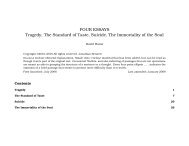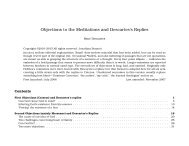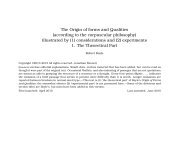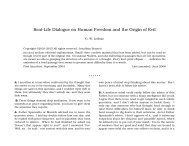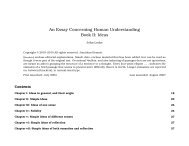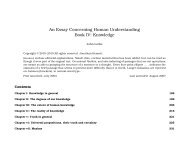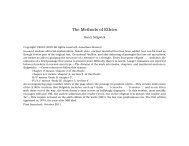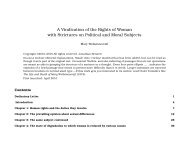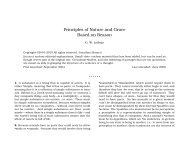The Form and Principles of the Sensible and Intelligible World
The Form and Principles of the Sensible and Intelligible World
The Form and Principles of the Sensible and Intelligible World
Create successful ePaper yourself
Turn your PDF publications into a flip-book with our unique Google optimized e-Paper software.
<strong>The</strong> <strong>Sensible</strong> <strong>and</strong> <strong>Intelligible</strong> <strong>World</strong> Immanuel Kant II: Distinguishing sensibles from intelligibles<br />
concerning things known sensitively. <strong>The</strong> truth <strong>of</strong> <strong>the</strong><br />
judgment x is F consists in <strong>the</strong> agreement <strong>of</strong> <strong>the</strong> predicate<br />
F with x, <strong>the</strong> subject <strong>of</strong> <strong>the</strong> judgment. Now, when x is a<br />
phenomenon, your only hold on it comes from its relation<br />
to your faculty <strong>of</strong> sensitive knowledge, <strong>and</strong> <strong>the</strong> predicate<br />
F—concerning something that is sensitively observable—<br />
comes to you through that same faculty. Thus, clearly, your<br />
representations <strong>of</strong> subject <strong>and</strong> predicate arise according to<br />
<strong>the</strong> same laws, <strong>and</strong> so provide for perfectly true knowledge.<br />
12. [Kant begins this paragraph with a defeatingly condensed sentence;<br />
what follows, down to <strong>and</strong> including (iv), gives <strong>the</strong> sentence’s content—<br />
with no additions, but re-organized.] In addition to •phenomena<br />
that are presented to our •senses, <strong>the</strong>re are items which<br />
(i) don’t come before our senses, <strong>and</strong> yet<br />
(ii) do belong on <strong>the</strong> sensitive side <strong>of</strong> <strong>the</strong> sensitive/intellectual<br />
line;<br />
<strong>and</strong> <strong>the</strong>y can satisfy both (i) <strong>and</strong> (ii) because <strong>the</strong>y<br />
(iii) present us with <strong>the</strong> form (but not <strong>the</strong> content) <strong>of</strong><br />
sensibility.<br />
<strong>The</strong>y satisfy (i) because <strong>the</strong>y present only form, not content;<br />
<strong>the</strong>y satisfy (ii) because what <strong>the</strong>y present <strong>the</strong> form <strong>of</strong> is<br />
sensibility. And I express all this by saying that <strong>the</strong>y<br />
(iv) present us with intuitions that are pure, i.e. empty <strong>of</strong><br />
sensations.<br />
<strong>The</strong> phenomena <strong>of</strong> outer sense are displayed <strong>and</strong> examined in<br />
•physics, <strong>and</strong> those <strong>of</strong> inner sense in empirical •psychology.<br />
But pure intuition (our pure intuition) is not<br />
•a universal or logical concept under which things are<br />
thought, but<br />
•a singular concept in which sensible things are<br />
thought,<br />
<strong>and</strong> so it contains <strong>the</strong> concepts <strong>of</strong> space <strong>and</strong> time.<br />
9<br />
[What is at work here is Kant’s three-part <strong>the</strong>sis that (a) all our intuitions<br />
have imposed on <strong>the</strong>m a certain form; (b) this form has to do with<br />
spatiality (for our outer intuitions) <strong>and</strong> temporality (for all our intuitions,<br />
inner <strong>and</strong> outer); <strong>and</strong> (c) we have to think <strong>of</strong> <strong>the</strong>se not in terms <strong>of</strong><br />
<strong>the</strong> general concepts <strong>of</strong> spatiality <strong>and</strong> temporality but in terms <strong>of</strong> two<br />
individuals, Space <strong>and</strong> Time. When we say that all physical objects are<br />
spatial, what we do or should mean is not that <strong>the</strong>y fall under <strong>the</strong> general<br />
concept <strong>of</strong> spatiality, but ra<strong>the</strong>r that <strong>the</strong>y are all in Space, in that one<br />
great big thing.]<br />
Since space <strong>and</strong> time have no effect on <strong>the</strong> qualities <strong>of</strong><br />
sensible things, <strong>the</strong>y don’t come into <strong>the</strong> science except<br />
in quantitative ways—·‘twice as big’, ‘gradually lessening<br />
speed’, ‘instantaneous’, <strong>and</strong> so on·. Pure ma<strong>the</strong>matics deals<br />
with space in •geometry, <strong>and</strong> with time in •pure mechanics.<br />
<strong>The</strong>re’s also <strong>the</strong> concept <strong>of</strong> number, which arithmetic deals<br />
with. It is an intellectual concept, but it can be applied to<br />
concrete situations only in harness with <strong>the</strong> notions <strong>of</strong> time<br />
<strong>and</strong> space: for example,<br />
•with time: counting <strong>the</strong> rotations <strong>of</strong> <strong>the</strong> earth around<br />
<strong>the</strong> sun;<br />
•with space: counting <strong>the</strong> planets.<br />
Thus, pure ma<strong>the</strong>matics deals with <strong>the</strong> form <strong>of</strong> all our sensitive<br />
knowledge, which makes it <strong>the</strong> organon [see Glossary] <strong>of</strong> all<br />
knowledge that is both intuitive <strong>and</strong> clear. And because its<br />
objects—·space <strong>and</strong> time·—are not only <strong>the</strong> formal principles<br />
<strong>of</strong> every intuition but are <strong>the</strong>mselves original intuitions, it<br />
provides us with entirely genuine knowledge while also giving<br />
us a model <strong>of</strong> <strong>the</strong> highest kind <strong>of</strong> certainty in o<strong>the</strong>r fields. So<br />
<strong>the</strong>re is a science <strong>of</strong> sensible things—·meaning ‘science in<br />
its stiffest <strong>and</strong> most dem<strong>and</strong>ing sense·—although intellect<br />
comes into it only in a •logical role, not in a •real role <strong>of</strong><br />
adding to <strong>the</strong> content <strong>of</strong> <strong>the</strong> science [see page 5]. . . .




